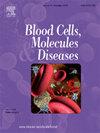Further biological characterization of small molecules UM171 and SR1: In vitro effects on three hematopoietic cell populations from human cord blood
IF 1.7
4区 医学
Q3 HEMATOLOGY
引用次数: 0
Abstract
Small molecules UM171 and SR1 have already been taken into clinically-oriented protocols for the ex vivo expansion of hematopoietic stem (HSCs) and progenitor (HPCs) cells. In order to gain further insight into their biology, in the present study we have assessed their effects, both individually and in combination, on the in vitro long-term proliferation and expansion of HSCs and HPCs contained within three different cord blood-derived cell populations: MNCs (CD34+ cells = 0.8 %), LIN− cells (CD34+ cells = 41 %), and CD34+ cells (CD34+ cells >98 %). Our results show that when added to cultures in the absence of recombinant stimulatory cytokines, neither molecule had any effect. In contrast, when added in the presence of hematopoietic cytokines, UM171 and SR1 had significant stimulatory effects on cell proliferation and expansion in cultures of LIN− and CD34+ cells. No significant effects were observed in cultures of MNCs. The effects of both molecules were more pronounced in cultures with the highest proportion of CD34+ cells, and the greatest effects were observed when both molecules were added in combination. In the absence of small molecules, cell numbers reached a peak by days 25–30, and then declined; whereas in the presence of UM171 or/and SR1 cell numbers were sustained up to day 45 of culture. Our results indicate that besides CD34+ cells, LIN− cells could also be used as input cells in clinically-oriented expansion protocols, and that using both molecules simultaneously would be a better approach than using only one of them.
小分子 UM171 和 SR1 的进一步生物学特征:对人类脐带血中三种造血细胞群的体外效应。
小分子 UM171 和 SR1 已被临床应用于体内外造血干细胞(HSCs)和祖细胞(HPCs)的扩增。为了进一步了解它们的生物学特性,我们在本研究中评估了它们单独或联合使用对三种不同脐带血细胞群中造血干细胞和造血祖细胞体外长期增殖和扩增的影响:MNCs(CD34+细胞=0.8%)、LIN-细胞(CD34+细胞=41%)和CD34+细胞(CD34+细胞>98%)。我们的研究结果表明,在没有重组刺激细胞因子的情况下,向培养物中添加这两种分子都不会产生任何影响。相反,当加入造血细胞因子时,UM171 和 SR1 对 LIN- 和 CD34+ 细胞培养物中的细胞增殖和扩增有显著的刺激作用。在 MNCs 培养中未观察到明显作用。在 CD34+ 细胞比例最高的培养物中,两种分子的作用更为明显,当两种分子联合添加时,观察到的作用最大。在没有小分子的情况下,细胞数量在第 25-30 天达到峰值,然后下降;而在有 UM171 或/和 SR1 的情况下,细胞数量可维持到培养的第 45 天。我们的研究结果表明,除了 CD34+ 细胞,LIN- 细胞也可用作临床导向扩增方案的输入细胞,同时使用两种分子比只使用其中一种分子更好。
本文章由计算机程序翻译,如有差异,请以英文原文为准。
求助全文
约1分钟内获得全文
求助全文
来源期刊
CiteScore
4.90
自引率
0.00%
发文量
42
审稿时长
14 days
期刊介绍:
Blood Cells, Molecules & Diseases emphasizes not only blood cells, but also covers the molecular basis of hematologic disease and studies of the diseases themselves. This is an invaluable resource to all those interested in the study of hematology, cell biology, immunology, and human genetics.

 求助内容:
求助内容: 应助结果提醒方式:
应助结果提醒方式:


